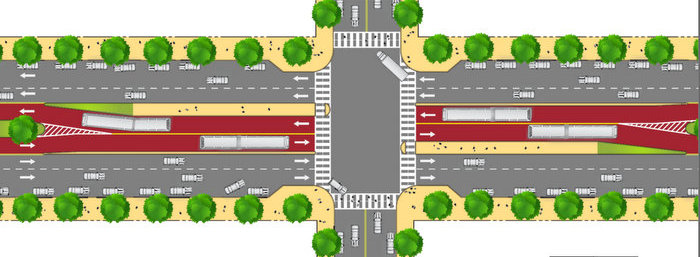Van Ness Bus Rapid Transit is now scheduled to open in 2018, two years later than the previous target of 2016. It's the latest setback for a project that was originally set to open in 2012.
In fleshing out the conceptual design approved in June 2012, the SF County Transportation Authority "encountered greater than expected challenges in reaching agreement with Caltrans," said Tilly Chang, the SFCTA's deputy director of planning. Caltrans said the traffic lanes in the plan were too narrow for the department’s highway design standards, according to Chang.
The SFCTA also ran into opposition to the removal of bus stops near a senior center, leading the agency to add an extra stop in each direction between Broadway and Vallejo Street, which is expected to slow the BRT line down. The obstacles are just the latest in a slew of factors that planners have cited for repeated delays.
"Bus rapid transit was proposed at the beginning of the century and it was billed as an alternative to rail because it could be built faster and more cheaply," said Jason Henderson, a member of the Van Ness BRT Citizens Advisory Committee and author of Street Fight: The Politics of Mobility in San Francisco.
"This is a true, signature project, and we should be doing this all over the city," he said. "If it takes this long to do a two-mile stretch, what lessons can we learn to go faster?"
The project's latest milestone came this week with the release the final environmental impact report. The SFCTA will also begin transferring management of the project to the SF Municipal Transportation Agency, which will oversee its construction and operation.
"We understand the public’s concerns about how long these projects are taking, and share their frustrations," Chang wrote in an email. "However, please know that the Authority and SFMTA are doing everything within our purview to speed up the design and construction process."
Chang said Caltrans, which has jurisdiction over Van Ness because it's part of Highway 101, had insisted that planners maintain 12-foot-wide traffic lanes by removing trees in the center median and car parking lanes, which provide a barrier between pedestrians and moving traffic. Eventually, the SFCTA convinced Caltrans to allow 10.5-foot-wide lanes on some stretches.
In an ongoing effort, the SFCTA is pushing Caltrans to reform its street standards to allow for safer designs in urban environments, said Chang.
The latest delay would have been even longer, she said, had the agency not sped up a funding grant for the SFMTA to begin its design process.
"The detailed design effort is now underway and the team continues to look for ways to pull in the schedule, while maintaining quality and public involvement," she said. "SFMTA is studying alternative delivery processes such as Design-Build (where the same contractor performs final design as well as construction) - this is a very positive development as it can really save time and enable the most efficient use of resources between the public and private sectors."
Chang said planners are also looking for ways to integrate the development of the Van Ness project with Geary BRT, another project that has been fraught with delays.
Henderson thinks BRT projects would move faster if they had political backing from members of the Board of Supervisors. "As it's built, they're going to have to shepherd this thing through and make sure that it doesn't get whittled down," he said.





